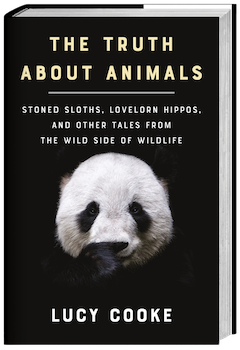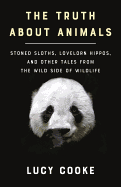The Truth About Animals: Stoned Sloths, Lovelorn Hippos, and Other Tales from the Wild Side of Wildlife
by Lucy Cooke
"I'm fascinated by the mistakes we've made," writes the award-winning documentary filmmaker and zoologist Lucy Cooke in The Truth About Animals: Stoned Sloths, Lovelorn Hippos, and Other Tales from the Wild Side of Wildlife. "They reveal much about the mechanics of discovery and the people doing the discovering." Here she refers to the scientists and philosophers who for millennia have studied the natural world only to come to some astonishingly terrible--and often hilarious--conclusions.
There was the medieval German scholar Sebastian Muenster, writes Cooke, who believed that "ostriches were capable of digesting absolutely anything, even iron." That mistake led to generations of naturalists shoving scissors and nails down the throats of the large birds. A few centuries later, Leonardo da Vinci popularized the myth that beaver testicles contain healing properties. Even more absurdly, he believed the animals bite off their own bits to avoid being captured by hunters.
That's all nonsense, of course, but facts seem to have rarely gotten in the way of influential people's myth building. That's the thesis of Cooke's funny and immensely engaging deep dive into the history of weird animal tales and the ways in which they've been perpetuated.
Each chapter explores the myths of a different animal, many of which can be traced as far back as ancient Greece (Aristotle proves to have been a frequent perpetuator of amusing beastie folklore). Cooke then upends these myths by discussing how modern science has busted most of them, only to create new--and sometimes stranger--myths to replace the old. Consider the myths of the chimpanzee: Renaissance-era explorers were "befuddled" by their humanlike traits and concluded that they must be a new form of human. Centuries later, writes Cooke, when the first chimp arrived in Britain in 1738, the English were so taken aback by its humanoid appearance they offered the animal a cup of tea: "It was said to have sipped it daintily."
Flash forward to the 20th century, and scientists have all but completely mapped the chimpanzee's genetic makeup, proving definitively that they are not human beings. But that didn't stop U.S. scientists in the 1960s from conducting an experiment wherein they transplanted a baby chimp into a human family "to be raised as a human in isolation from its own species." As one might expect, the results of this experiment were mixed and ultimately upsetting. But Cooke manages to eke hilarity out of this scientific misstep through her wry writing style and by recounting the more amusing aspects of the study: "At around the age of three," she reports, the chimp "acquired a taste for alcohol after she swiped a drink from the nervous wife of a visiting academic."
Other highlights include a chapter on the sloth, which corrects the idea that the languorous mammals are lazy (their metabolisms, explains Cooke, are just very slow). And in a chapter on moose, Cooke explains that the "goofy looking" animals with a "certain long-suffering, lugubrious look" are not as melancholy as many people think. Actually, the moose is "a badass beast" with a penchant for getting drunk on fermented wild fruit.
Page after page, Cooke's descriptions of animal myths speak volumes about humanity's hubris and faulty powers of deduction. But instead of teetering into depressing contemplations about how we continue to stray from the scientific ideal, Cooke acknowledges that "there is a (scientific) method to the madness," that such mistakes are rooted in assumptions that are often very close to the truth.
Cooke, who's trained as a zoologist and has written extensively on animals (her first book, A Little Book of Sloth, was a New York Times bestseller), recounts her own time spent searching for the truth, and these moments are perhaps the book's funniest. While researching beaver myths, for example, she tasted a secretion from a beaver gland to see if it indeed would cure her fever as the ancients believed. The results of this self-experiment are disgusting and completely worth the price of the book. In a later chapter, she describes her experiences observing chimpanzees in the wild, only to have her reverie "shattered by the sound of a fart." Yes, wild chimpanzees, we learn, are so renowned for their gaseous emissions that scientists have learned to locate the elusive animals by listening for "the sound of distant trumpets."
The book transcends mere irreverence, however. Taken together, these amusing--and insightful--chapters present at least two important conclusions that all humans, scientists and laypersons alike, would do well to remember: first, human arrogance has resulted in "many of our most misguided mistakes" and that "in these times of mass extinction, we cannot afford to make many more." And second, that while "wrong turns are an essential part of all scientific progress," we must keep on. In an era where some of the most powerful people in the world seek to discredit science, "there has never been a greater need for truth."
Well-researched and written with an eye for the absurd, The Truth About Animals reveals that we don't know as much about the animal world as we think we do. --Amy Brady







